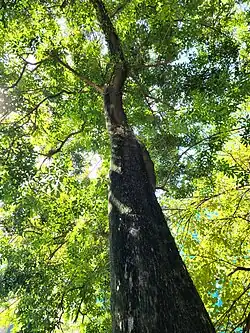Vitex quinata
| Vitex quinata | |
|---|---|

| |
| Scientific classification | |
| Kingdom: | Plantae |
| Clade: | Tracheophytes |
| Clade: | Angiosperms |
| Clade: | Eudicots |
| Clade: | Asterids |
| Order: | Lamiales |
| Family: | Lamiaceae |
| Genus: | Vitex |
| Species: | V. quinata
|
| Binomial name | |
| Vitex quinata | |
| Synonyms[3] | |
| |
.jpg)
Vitex quinata is a species of flowering plantin the family Lamiaceae.[4] It is sometimes referred to by the common name joho lawe tree. It is native to the Andaman Islands, Assam (India), Bangladesh, the Bismarck Archipelago, Borneo, Cambodia, the Caroline Islands, South-Central China, Southeast China, the East Himalayas, Hainan (China), India, Java (Indonesia), Laos, the Lesser Sunda Islands (Indonesia), Malaysia, Maluku (Indonesia), Myanmar, Nansei-shoto, New Guinea, Pakistan, Philippines, Sulawesi (Indonesia), Sumatra (Indonesia), Taiwan, Thailand, and Vietnam.[3]
Uses
Some sources claim the bark is used as a tonic in folk medicine where an infusion can be made to increase appetite.[5]
References
- ^ Hills, R. (2019). "Vitex quinata". IUCN Red List of Threatened Species. 2019: e.T62019905A62019907. doi:10.2305/IUCN.UK.2019-2.RLTS.T62019905A62019907.en. Retrieved July 11, 2025.
- ^ "Vitex quinata (Lour.) F.N.Williams". www.gbif.org. Retrieved 26 April 2024.
- ^ a b "Vitex quinata (Lour.) F.N.Williams | Plants of the World Online | Kew Science". Plants of the World Online. Retrieved 2024-04-26.
- ^ "Vitex quinata (Lour.) F.N.Williams". Catalogue of Life. Species 2000. n.d. Retrieved July 11, 2025.
- ^ "Vitex quinata – Useful Tropical Plants". tropical.theferns.info. Retrieved 2024-04-26.
